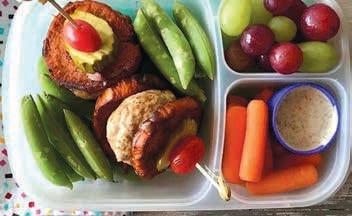
7 minute read
Childhood Food Allergies, Intolerances and Sensitivities
BACK-TO-SCHOOL TIPS FOR ALL AGES
by Veronica Hinke
It’s back-to-school season, and for students with food issues, meal planning is as important as lining up classroom supplies and extracurricular schedules. Paramount in their minds is to avoid ingredients that might cause unappealing reactions or compromise health, while not stressing about the risks or feeling cheated that they cannot eat the same things as their friends.
Diagnosis
Often, food allergies, sensitivities and intolerances are incorrectly used interchangeably when, in fact, the symptoms, treatments and safety recommendations differ. Consult a physician for a proper diagnosis and a nutritionist for dietary guidance.
FOOD ALLERGIES cause an almost immediate, potentially deadly immune response (anaphylaxis) requiring an epinephrine shot. Symptoms include a drop in blood pressure, narrowing of the airways, rashes, nausea and vomiting. The U.S. Centers for Disease Control and Prevention (CDC) estimates that 20 percent of students with food allergies will have a reaction at school. Eight ingredients account for 90 percent of food allergies: milk, eggs, fish, shellfish, tree nuts, peanuts, wheat and soybeans.
FOOD INTOLERANCES result from an inability to digest certain foods due to an enzyme deficiency or irritable bowel syndrome. The most common forms of intolerance are caused by lactose, histamine and gluten.
FOOD SENSITIVITIES provoke delayed symptoms (sometimes days after eating a problematic ingredient), including diarrhea, rashes, joint pain, digestive problems, fatigue and brain fog. Among children, common triggers are lactose, gluten, grains, legumes, soy, corn and yeast.
Emotional Concerns
According to Karen Raden, an Illinoisbased registered dietician and certified clinical nutritionist, the goal is what she calls “food freedom”: the empowerment of students to make informed choices that feel best for them and their bodies. “Even if a child’s options are limited, it’s important to allow them to make substitutions. The less restricted, the better. It’s not just about the science; there’s a lot of emotion that goes into it, too,” she says.
Dr. Dawn Huebner, a psychologist, author and parent coach in Sacramento, California, says, “There is danger associated with allergies, and anxiety results when you overestimate the danger. In children, this can morph into anxiety about eating with other people or touching things in the classroom. Many parents are intent on making uncomfortable feelings go away, so they end up minimizing feelings, telling their children to simply not worry.”
A better approach, Huebner says, is to acknowledge the child’s reality and empathize with them. “Say to your child in a really direct way, ‘Yes, that’s hard to see your friends eating ice cream or cupcakes that you don’t get to have.’ Even though there are food substitutions, it doesn’t make up for the fact that a student doesn’t get to be a regular kid, eating what everyone else gets to eat.”
Ready-to-Eat Options
Huebner suggests that parents help their children develop skills to overcome temptation, rather than berating or punishing them for occasionally sneaking forbidden foods. At all times, delicious alternatives should be readily available.
Theresa Diulus, a Texas-based nutrition coach, believes in empowering kids by keeping ready-made foods in clearly marked bins that kids can easily access. She stocks the pantry with gluten-free oatmeal and coconut or cassava flour cake mixes, and stores frozen, gluten-free waffle or pancake batter in batches to save time when a safe and delicious treat is needed.
Food Substitutions
Replacing essential nutrients that might be missing once certain foods are eliminated is another key objective. “If dairy is the problem, for example, we worry about bone health and need to make sure the child is getting calcium from nondairy sources,” Raden explains. “I like to find out what their favorite foods are and modify them. Food issues are more prevalent these days. We’re really lucky now that there are very good substitutes for eggs, dairy and gluten.”
Raden recently adapted a shepherd’s pie recipe by using gluten-free flour and almond milk. For people that cannot tolerate regular eggs, she recommends using a “flax egg” in baked goods, which combines one tablespoon of flaxseed meal with three tablespoons of water.
Family Meals Made Easy
When they were little, Caroline Somers’ two daughters developed extensive food intolerances and food allergies with inflammation, gastrointestinal bloating and digestive distress. Tasked with reimagining her family’s diet, the president of Suzanne Somers Companies created new versions of her favorite recipes, which will be featured in her upcoming cookbook, Served: From My Family Table to Yours.
“Many people deal with family members who have food preferences or intolerances to foods, and it can turn the person preparing foods into a short-order cook—no gluten for this one; vegan for that one; this one will eat fish but no dairy. It can make your head spin,” says Somers. Her Vietnamese Spring Rolls recipe addresses this predicament by serving the ingredients family-style and inviting each person at the table to assemble their own spring roll according to their food preferences and restrictions.
Veronica Hinke is a food historian and author of The Last Night on the Titanic: Unsinkable Drinking, Dining and Style.
To accommodate a family with differing dietary needs due to food allergies, sensitivities or intolerances, this dish is served family-style, allowing diners to assemble their own spring rolls, choosing from the ingredients that fit their food restrictions.

YIELD: 24 SPRING ROLLS (6 ENTREE SERVINGS, 10 APPETIZER SERVINGS)
1 8-oz package of 8¾-inch rice spring roll wrappers (24 wrappers)
1 bunch Thai basil (or Italian basil), leaves only
1 bunch fresh mint, leaves only
1 bunch fresh cilantro, leaves only
3 cups coconut jade pearl rice (recipe below)
2 mangoes or papayas, pitted, peeled and sliced into long, thin strips
4 Persian cucumbers, julienned into long, thin strips
6 carrots, julienned into long, thin strips
¼ cup crispy ginger (recipe below)
1 head romaine lettuce, thinly sliced
1 head red leaf lettuce, thinly sliced
2 cups sesame ginger vinaigrette (recipe below)
1 cup peanut sauce (recipe below)
Sriracha to taste
COCONUT JADE PEARL RICE
1 15-oz bag (2¼ cups) Lotus Foods Jade Pearl Rice (or jasmine rice)
1 14-oz can unsweetened coconut milk
1¼ cups water
Pinch of sea salt
Do not rinse the rice. Combine rice, coconut milk, water and salt in a pot and bring to a boil. Cover, reduce the heat to a simmer and cook for 20 minutes. Remove from the heat and let stand for 10 minutes. Fluff with a fork and serve. Can also be prepared in a rice cooker with the same ratios.
Crispy Ginger
1 palm-sized piece of fresh ginger
½ cup toasted sesame oil
Peel the ginger and thinly dice it. Heat the oil in a sauté pan over medium-high heat. Add the diced ginger and fry until golden brown—approximately 6 to 8 minutes—stirring frequently to brown evenly. Transfer the crispy ginger to a small serving bowl with a tiny spoon.
Sesame Ginger Vinaigrette
1 cup toasted sesame oil
¾ cup rice wine vinegar
¼ cup tamari (or soy sauce)
2 Tbsp grated fresh ginger
1 Tbsp dried hot mustard
Combine all the ingredients in a jar with fitted lid. Cover and shake until well combined. Store in the refrigerator for up to 2 months.
PEANUT SAUCE
½ cup creamy peanut butter
1 Tbsp grated fresh ginger
2 cloves garlic, pressed
2 Tbsp palm sugar
2 Tbsp sweet chili sauce
1 lime, juiced
1 Tbsp rice wine vinegar
1 Tbsp tamari (or soy sauce)
1 Tbsp toasted sesame oil
2 to 3 Tbsp warm water
Heat the peanut butter in a medium bowl in the microwave for 20 to 30 seconds. Add the ginger, garlic, sugar, chili sauce, lime juice, vinegar, tamari and sesame oil, and whisk to combine. Add the warm water to thin the sauce to desired consistency. Store in a covered jar in the refrigerator for up to 2 months.
To assemble a spring roll, dip one rice wrapper completely in a shallow bowl of warm water for about 5 seconds. Remove and spread flat on a plate or chopping board. Place basil leaves down the center. Continue to top the single strip with mint, cilantro, a thin layer of rice, mango, cucumber, carrot, a few pieces of crispy ginger and lettuce. Do not overstuff.
Fold up the bottom first, then fold over one side of the wrapper, tucking and rolling the filling into a compact cylinder, leaving the top end open. Serve the rolls with bowls of sesame ginger vinaigrette, peanut sauce and sriracha. Repeat to make desired number of rolls, using any combination of ingredients.
Recipe and photo courtesy of Caroline Somers.
Turkey Burger Bento Box

YIELD: 4 SERVINGS
BURGERS
1 lb ground turkey
¼ tsp onion powder
¼ tsp garlic powder
¼ tsp paprika
1 tsp salt
1 Tbsp avocado oil
SWEET POTATO “BUNS”
1 large sweet potato, peeled and sliced into ⅓-inch slices
2 to 3 Tbsp avocado oil
In a medium bowl, combine ground turkey and spices until mixed well, but don’t over-mix. Wet hands and divide mixture into 8 equal portions, then form into patties. Pat down really flat, as they will plump up when they cook.
Heat a cast iron skillet or heavy cooking pan over medium heat, then add avocado oil and swirl pan to cover the bottom. Add the meat patties and cook until the internal temperature reaches 165º F, approximately 4 to 5 minutes on each side.
For the sweet potato buns, heat a cast iron skillet or a heavy cooking pan over medium heat, then add avocado oil and swirl the pan to cover the bottom. Add the sweet potato slices and cook until golden and tender but not mushy, about 3 to 5 minutes on each side.
To assemble the bento box, place two burgers in the largest compartment and add fresh veggies and fruits to the smaller compartments.
Recipe and photo courtesy of Theresa Diulus.
Asian Glazed Chicken With Broccoli

This recipe uses gluten-free tamari instead of soy sauce for the glaze and rice flour instead of gluten-containing white flour to lightly coat the chicken, helping to keep the meat juicy and tender.
YIELD: 4 SERVINGS
1 to 2 chicken breasts (depending on size), cut into 1-inch pieces
¼ cup rice flour
½ tsp salt
2 grinds of fresh pepper
3 Tbsp vegetable oil
1-inch section of ginger root, peeled and chopped
1 scallion, sliced
1 broccoli crown, chopped
ASIAN GLAZE
1 Tbsp gluten-free tamari
1 tsp rice wine vinegar
½ tsp toasted sesame oil
2 tsp honey
In a bowl, combine the rice flour with salt and pepper. Toss the chicken in the mixture and set aside. In a large, nonstick pan, heat 1 tablespoon oil on medium high heat and add the ginger and white part of the scallions, quickly stir frying for 1 minute. Add the broccoli and continue cooking until slightly tender. Remove from the pan to a platter.
Add the remaining 2 tablespoons of oil to the pan. Cook the chicken, stirring occasionally until lightly browned on all sides. Meanwhile, stir together the glaze ingredients in a small bowl. Once the chicken is cooked, add the glaze to the pan and cook for 1 minute to thicken it. Add the broccoli and remaining green parts of the scallions and combine to heat through. Serve over rice or noodles.
Recipe and photo courtesy of Chicago-based pastry chef and cookbook author Gale Gand.







